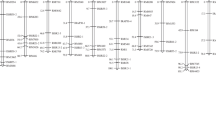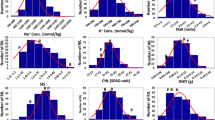Abstract
Salinity is the second most important abiotic stress after drought that hampers rice production, especially in south and Southeast Asia. Breeding approach supplemented with molecular markers-assisted selection is the most promising approach in terms of efficiency to increase the productivity under salt-affected soils. Thirty-day-old rice seedlings of 300 \(\hbox {F}_{5:6 }\) recombinant-inbred lines derived from a cross between the salt sensitive, IR29 (indica), and a salt tolerant, Hasawi (aus), were used to identify quantitative trait loci (QTLs) linked to salinity tolerance. One hundred and ninety four polymorphic SNP markers were used to construct a genetic linkage map involving 142 selected RILs that covered 1441.96 cM genome with an average distance of 7.88 cM between loci. Twenty new QTLs (LOD > 3) were identified on chromosomes 1, 2, 4, 6, 8, 9 and 12 using composite interval mapping with \(R^{2}\) as high as >20% with LOD value of 7.21. Many earlier studies reported big qSaltol for seedling stage salinity tolerance in rice is on short arm of chromosome 1 but none of the QTL in our study was on qSaltol or nearby position, therefore, Hasawi conferred salinity tolerance in RILs due to novel QTLs. It is suggested to fine map the novel QTLs so that the level of salinity tolerance could be further enhanced by pyramiding of the different QTLs in one genetic background through marker-assisted selection.



Similar content being viewed by others
References
Ahmed M. A., Islam M. M., Begum S. N., Halder J. and Ahmed M. H. 2010 Evaluation of \(\text{ F }_{3}\) rich lines of JANGLIBORO\(\times \) BRRI Dhan40 for salt tolerance using SSR markers. Int. J. Biores. 1, 1–5.
Alam R., Sazzadur Rahman M., Seraj Z. I., Thomson M. J., Ismail A. M., Tumimbang-Raiz E. and Gregorio G. B. 2011 Investigation of seedling-stage salinity tolerance QTLs using backcross lines derived from Oryza sativa L. Pokkali. Plant Breed. 130, 430–437.
Ammar M. H. M., Singh R. K., Singh A. K., Mohapatra T., Sharma T. R. and Singh N. K. 2007 Mapping QTLs for salinity tolerance at seedling stage in rice (Oryza sativa L.). Afr. Crop Sci. Conf. Proc. 1, 617–620.
Baby J., Jini D. and Sujatha S. 2010 Biological and physiological perspectives of specificity in abiotic salt stress response from various rice plants. Asian J. Agri. Sci. 2, 99–105.
Bimpong I. K., Manneh B., Diop B., Ghislain K., Sow A., Amoah N. K. A. et al. 2014a New quantitative trait loci for enhancing adaptation to salinity in rice from Hasawi, a Saudi landrace into three African cultivars at the reproductive stage. Euphytica 200, 45–60.
Bimpong I. K., Manneh B., Namaky R., Diaw F., Amoah N. K. A., Sanneh B. et al. 2014b Mapping QTLs related to salt tolerance in rice at the young seedling stage using 384-plex single nucleotide polymorphism SNP, marker sets. Mol. Plant Breed. 5, 47–63.
Bimpong I. K., Manneh B., Sock M., Diaw F., Amoah N. K. A., and Ismail A. M. 2016 Improving salt tolerance of lowland rice cultivar ‘Rassi’ through marker-aided backcross breeding in West Africa. Plant Sci. 242, 288–299.
Collard B. C. Y., Jahufer M. Z. Z., Brouwer J. B. and Pang E. C. K. 2005 An introduction to markers, quantitative trait loci (QTL) mapping and marker-assisted selection for crop improvement: The basic concepts. Euphytica 142, 169–196.
De Leon T. B., Linscombe S. and Subudhi P. K. 2016 Molecular dissection of seedling salinity tolerance in rice (Oryza sativa L.) using a high-density GBS-based SNP linkage map. Rice 9, (doi:10.1186/s12284-016-0125-2).
Famoso A. N., Zhao K., Clark R. T., Tung C.-W., Wright M. H., Bustamante C. et al. 2011 Genetic architecture of aluminum tolerance in rice (Oryza sativa) determined through genome-wide association analysis and QTL mapping. PLoS Genet. 7, e1002221.
Flowers T. J. 2004 Improving crop salt tolerance. J. Exp. Bot. 55, 307–319.
Gregorio G. B. 1997 Tagging salinity tolerance genes in rice using amplified fragment length polymorphism (AFLP). Ph.D. thesis, University of Philippines, Los Baños, Laguna, Philippines.
Gregorio G. B., Senadhira D. and Mendoza R. D. 1997 Screening rice for salinity tolerance. Int. Rice Res. Inst. 3–19.
GRISP (Global Rice Science Partnership) 2013 Rice almanac, 4th edition, pp. 283. International Rice Research Institute, Los Baños, Philippines.
Haq T. U. 2009 Molecular mapping of \(\text{ Na }^{+}\) accumulation quantitative trait loci (QTLs) in rice (Oryza sativa L.) under salt stress. Ph.D. thesis, University of Agriculture, Fasialabad, Pakistan.
IRRI 2007 Standard evaluation system for rice (SES), 4th edition, pp. 52. Philippines International Rice Research Institute, Los Banos, Philippines.
Islam M. R., Salam M. A., Hassan L., Collard B. C. Y., Singh R. K. and Gregorio G. B. 2011 QTL mapping for salinity tolerance at seedling stage in rice. Emir. J. Food Agric. 23, 137–146.
Joehanes R. and Nelson J. C. 2008 QGene 4.0, an extensible Java QTL-analysis platform. Bioinformatics 24, 2788–2789.
Kanjoo V., Jearakongman S., Punyawaew K., Siangliw J. L., Siangliw M., Vanavichit A. and Toojinda T. 2011 Co-location of quantitative trait loci for drought and salinity tolerance in rice. Thai J. Genet. 4, 126–138.
Koyama M. L., Levesley A., Koebner R. M. D., Flowers T. J. and Yeo A. R. 2001 Quantitative trait loci for component physiological traits determining salt tolerance in rice. Plant Physiol. 125, 406–422.
Kumar V., Singh A., Amitha Mithra S. V., Krishnamurthy S. L., Parida S. K., Jain S. et al. 2015 Genome-wide association mapping of salinity tolerance in rice (Oryza sativa). DNA Res. 22, 133–145.
Lander E. S. and Botstein D. 1989 Mapping mendelian factors underlying quantitative traits using RFLP linkage maps. Genetics 121, 185–199.
Läuchli A. and Grattan S. R. 2007 Plant growth and development under salinity stress. In Advances in molecular breeding toward drought and salt tolerant crops (ed. M. A. Jenks, P. M. Hasegawa and S. M. Jain), pp. 1–32. Springer, Netherlands, USA.
Lee S. Y., Ahn J. H., Cha Y. S., Yun D. W., Lee M. C., Ko J. C. et al. 2006 Mapping of quantitative trait loci for salt tolerance at the seedling stage in rice. Mol. Cells 21, 192–196.
Lin J. Z. and Ritland K. 1996 The effects of selective genotyping on estimates of proportion of recombination between linked quantitative trait loci. Theor. Appl. Genet. 93, 1261–11266.
Masood M. S., Seiji Y., Shinwari Z. K. and Anwar R. 2004 Mapping quantitative trait loci (QTLs) for salt tolerance in rice (Oryza sativa) using RFLPs. Pak. J. Bot. 36, 825–834.
Meksem K. and Kahl G. 2005 The handbook of plant genome mapping: genetic and physical mapping. Wiley-Vch Verlag GmbH, Weinheim, Germany.
Milne I., Shaw P., Stephen G., Bayer M., Cardle L., Thomas W. T. B. et al. 2010 Flapjack-graphical genotype visualization. Bioinformatics 26, 3133–3134.
Ming-zhe Y., Jian-fei W., Hong-you C., Hu-qu Z. and Hong-sheng Z. 2005 Inheritance and QTL mapping of salt tolerance in rice. Rice Sci. 2, 25–32.
Munns R. and Tester M. 2008 Mechanisms of salinity tolerance. Ann. Rev. Plant Biol. 59, 651–681.
Murray M. G. and Thompson W. F. 1980 Rapid isolation of high molecular weight plant DNA. Nucl. Acids Res. 8, 4321–4325.
Niones J. M. 2004 Fine mapping of the salinity tolerance gene on chromosome 1 of rice (Oryza sativa L.) using near isogenic lines. MS dissertation. College, Laguna, Philippines: MSc thesis, University of the Philippines, Los Baños, Laguna.
Rahman M. A., Thomson M. J., Alam M. S., De Ocampo M., Egdane J. and Ismail A. M. 2016 Exploring novel genetic sources of salinity tolerance in rice through molecular and physiological characterization. Ann. Bot. 117, 1083–1097.
Ray P. K. S. and Islam M. A. 2008 Genetic analysis of salinity tolerance in rice. Bangladesh J. Agril. Res. 33, 519–529.
Sabouri H. and Sabouri A. 2008 New evidence of QTLs attributed to salinity tolerance in rice. Afr. J. Biotechnol. 7, 4376–4383.
Semagn K., Bjørnstad Å. and Ndjiondjop M. N. 2006 Principles, requirements and prospects of genetic mapping in plants. Afr. J. Biotechnol. 5, 2569–2587.
Singh B. D. 2012 Plant breeding: principles and methods. Kalyani Publishers, New Delhi, India.
Singh R. K. and Flowers T. J. 2010 The physiology and molecular biology of the effects of salinity on rice. In Handbook of plant and crop stress (ed. M. Pessarakli), pp. 901–942. Taylor and Francis, Florida, USA.
Singh R. K., Gregorio G. B. and Jain R. K. 2007 QTL mapping for salinity tolerance in rice. Physiol. Mol. Biol. Plants 13, 87–99.
Singh R. K., Redoña E. and Refuerzo L. 2010 Varietal improvement for abiotic stress tolerance in crop plants: special reference to salinity in rice. In Abiotic stress adaptation in plants: physiological, molecular and genomic foundation (ed. A. Pareek, S. K. Sopory, H. J. Bohnert and Govindjee), pp. 387–415. Springer, Netherlands, Germany.
Tanksley S. D., Young N. D., Paterson A. H. and Bonierbale M. W. 1989 RFLP mapping in plant breeding: new tools for an old science. Biotechnology 7, 257–264.
The H. V. 2010 QTL mapping and marker-assisted backcrossing for developing salinity tolerant rice (Oryza sativa L.). M.Sc. thesis, University of Philippines, Los Baños, Laguna, Philippines.
Thomson M. J. 2009 Marker-assisted breeding for abiotic stress tolerance in rice: progress and future perspectives. International Symposium, Rice Research in the Era of Global Warming, pp. 43–55. Taiwan Agricultural Research Institute, Taichung, Taiwan.
Thomson M. J. 2014 High-throughput SNP genotyping to accelerate crop improvement. Plant Breed. Biotech. 2, 195–212.
Thomson M. J., De Ocampo M., Egdane J., Rahman M. A., Sajise A. G., Adorada D. L. et al. 2010 Characterizing the Saltol quantitative trait locus for salinity tolerance in rice. Rice 3, 148–160.
Thomson M. J., Zhao K., Wright M., McNally K. L., Rey J., Tung C.-W. et al. 2012 High-throughput single nucleotide polymorphism genotyping for breeding applications in rice using the BeadXpress platform. Mol. Breed. 29, 875–886.
Tuberosa R., Salvi S., Sanguineti M. C., Landi P., Maccaferri M. and Conti S. 2002 Mapping QTLs regulating morpho-physiological traits and yield: case studies, shortcomings and perspectives in drought-stressed maize. Ann. Bot. 89, 941–963.
Veldboom L. R., Lee M. and Woodman W. L. 1994 Molecular-marker facilitated studies in an elite maize population: I. Linkage analysis and determination of QTLs for morphological traits. Theor. Appl. Genet. 88, 7–16.
Vinod K. K. 2006 Genome mapping in plant population. In Proceedings of training programme on modern approaches in plant genetics resources-collection, conservation and utilization, pp. 402–414. Tamil Nadu Agricultural University, Coimbatore, India.
Wang S., Basten C. J. and Zeng Z. B. 2011 Windows QTL Cartographer 2.5. North Carolina State University, Raleigh, USA.
Wright M., Tung C. W., Zhao K., Reynolds A., McCouch S. R. and Bustamante C. D. 2010 ALCHEMY: a reliable method for automated SNP genotype calling for small batch sizes and highly homozygous populations. Bioinformatics 26, 2952–2960.
Xiao J., Li J., Yuan L. and Tanksley S. D. 1996 Identification of QTLs affecting traits of agronomic importance in a recombinant inbred population derived from a sub specific rice cross. Theor. Appl. Genet. 92, 230–244.
Yadav S., Irfan M., Ahmad A. and Hayat S. 2011 Causes of salinity and plant manifestations to salt stress: a review. J. Environ. Biol. 32, 667–685.
Acknowledgements
The authors thank Ms Marydee Arceta for technical assistance in the genotyping. Technical editing by Dr Bill Hardy is sincerely acknowledged. Help from head of the Plant Breeding, Genetics and Biotechnology Division is duly acknowledged for permission to conduct the research at IRRI. Authors also acknowledge the funding support of Japan Rice Breeding Project for MSc degree and to carry out the research.
Author information
Authors and Affiliations
Corresponding author
Additional information
Corresponding editor: U. C. Lavania
Rights and permissions
About this article
Cite this article
Bizimana, J.B., Luzi-Kihupi, A., Murori, R.W. et al. Identification of quantitative trait loci for salinity tolerance in rice (Oryza sativa L.) using IR29/Hasawi mapping population. J Genet 96, 571–582 (2017). https://doi.org/10.1007/s12041-017-0803-x
Received:
Revised:
Accepted:
Published:
Issue Date:
DOI: https://doi.org/10.1007/s12041-017-0803-x




